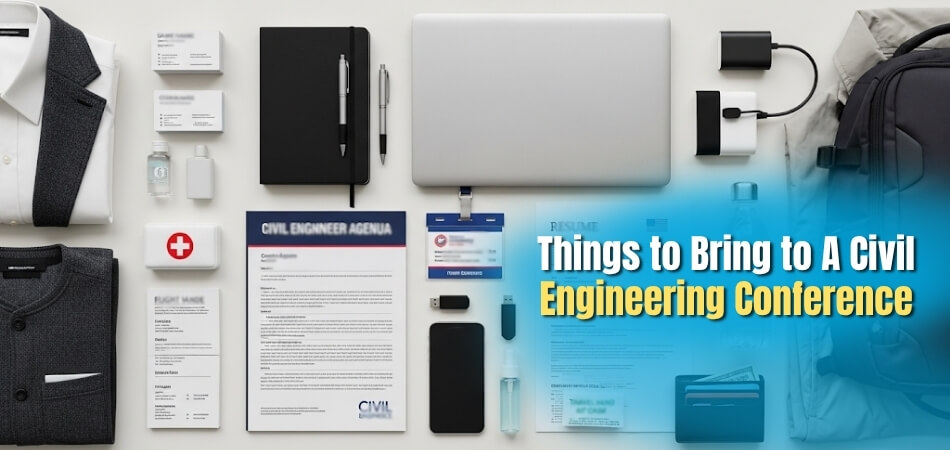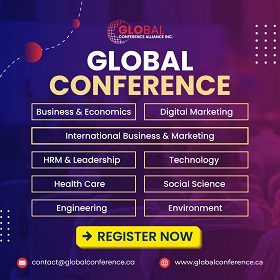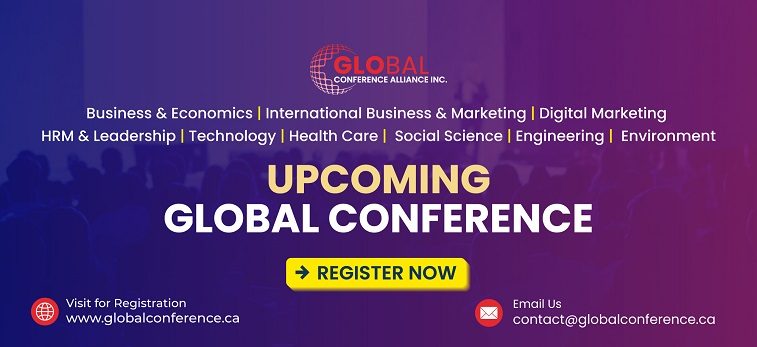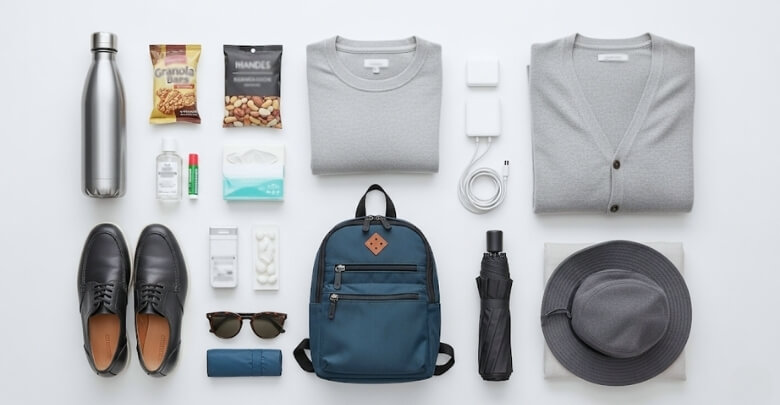You can learn new things and meet new people if you attend a civil engineering conference in the USA. It’s a great chance to make connections, share ideas, and see new trends in the industry. To get the most from your trip, it’s important to pack the right things and be prepared.
If you are asking what to bring to a civil engineering conference in the USA, here’s what you should keep in mind:
Bring essentials like your ID, conference registration details, business cards, a notebook or tablet for notes, comfortable business-casual clothing, and weather-appropriate footwear. Don’t forget chargers, a reusable water bottle, and any personal medications. Packing smart helps you stay focused, comfortable, and ready to network.
Want more helpful tips? Read on for more advice on how to be ready for your next conference!
What to Bring to a Civil Engineering Conference in the USA?
Packing for a civil engineering conference in the USA takes careful planning and attention to detail. You’ll want to feel prepared, comfortable, and confident for every session and networking event. Bringing the right items makes your experience smoother and more productive. A simple checklist helps you get the most out of the conference.
Business Cards
Business cards are your best networking tool at any professional event. Bring at least 50–100 cards with your name, title, company, and contact information. Share them during sessions, workshops, or when meeting new contacts between presentations. Always keep some cards in your pocket for quick access throughout the day.
A good business card includes your email and a link to your LinkedIn or portfolio. Neatly designed cards show your attention to detail and professionalism. Exchanging cards often leads to follow-up conversations and potential collaborations. Make sure your cards are updated and easy to read.
Professional Attire
Choose your outfit based on the conference dress code, usually shared on the event’s website. Business casual or formal attire is most common at engineering events in the USA. Think blazers, dress shirts, slacks, or skirts for a polished look. Comfortable shoes are a must since you’ll walk and stand a lot.
Look for wrinkle-free, breathable fabrics to stay fresh and comfortable during long days. Layering helps if venues are cold from air conditioning. Smart attire makes a strong first impression and helps you feel confident in any setting. Always bring an extra outfit for unexpected spills or weather changes.
Notebook and Pens
A notebook and a few pens are essential for jotting down key points during talks or workshops. Small, portable notebooks fit easily in your bag or pocket. Taking handwritten notes helps you remember important ideas and names from the sessions. Pen and paper can be quicker than digital devices in busy environments.
You might want to record questions, interesting facts, or contact details during networking breaks. Some people prefer using colored pens for easy sorting of topics. Extra pens ensure you don’t run out of ink at a crucial moment. Bring a spare notebook if you expect to attend many sessions.
Laptop or Tablet
Bringing a laptop or tablet helps you stay connected, organized, and productive throughout the conference. Use it to take notes, review materials, or check your schedule. Download the agenda, presentations, or other important documents in advance. Don’t forget to pack a charger to keep your device powered all day.
Many conferences offer free Wi-Fi, but check ahead to be sure. Laptops are useful for working on presentations or following up on emails. Tablets are lighter and perfect for quick reading or accessing mobile apps. Secure your device in a padded case to prevent damage when traveling between venues.
Conference Materials
Download or print the conference agenda and any pre-conference materials provided by the organizers. Some events use mobile apps or digital guides instead of paper handouts. Review the schedule to highlight sessions you want to attend or speakers you want to meet. Keep a printed ticket or confirmation email handy for quick check-in.
Digital access to materials helps you stay updated on changes or room assignments. Make notes next to session titles for questions or discussion points. Having all your materials in one folder saves time searching later. Don’t forget to bookmark important pages in the event app.
Portable Charger
A portable charger keeps your devices running during long conference days. Charging stations may not always be available or convenient at busy venues. Choose a reliable charger that holds enough power for your phone, tablet, or other electronics. Keep your charger in an easy-to-reach pocket for quick access.
Charge your devices each night and check battery levels before leaving your hotel. Many networking opportunities and event updates happen through apps or texts. Missing a message because of a dead battery can cost you valuable connections. Extra charging cables are helpful if you lose or misplace one.
Reusable Water Bottle and Snacks
Staying hydrated and energized during the conference is very important. Bring a reusable water bottle that you can refill throughout the day. Some conferences may not provide enough breaks for water or snacks. Healthy snacks like granola bars, nuts, or fruit keep your energy up between sessions.
Drinking enough water helps you focus and keeps you feeling your best. Portable snacks prevent hunger during long talks or workshops. Choose bottles that are easy to carry and won’t leak in your bag. Having your own snacks also saves money if food options are limited or expensive.
Technical Resources
If you plan to present or discuss your work, bring technical resources like USB drives or project files. Save your presentations, reports, or CAD drawings in multiple formats for compatibility. Make sure your files open correctly on different devices or conference AV systems. Back up your files online for extra security.
Review the conference requirements for presenters ahead of time. Having a backup USB drive can save you if your primary one fails. If you’re networking, show your project portfolio digitally or as printed samples. Technical materials help spark deeper conversations about your work and skills.
Identification and Travel Documents
Always carry a government-issued ID for conference check-in and travel needs. Bring your registration confirmation, hotel bookings, and flight details in a folder or app. Keep all important documents together in a secure place. Check that your ID is valid and not expired before you travel.
Travel documents help you move smoothly through airports and hotels. Some conferences require proof of registration for entry to sessions. Digital copies on your phone are helpful in case you misplace a paper version. Organize your paperwork before the trip to avoid last-minute stress.
Personal Items
Pack personal essentials such as a small first-aid kit, medications, hand sanitizer, and a light jacket. Air-conditioned venues can be chilly, so a jacket helps you stay comfortable. Basic first-aid supplies are useful for small cuts or headaches. Hand sanitizer keeps you healthy when meeting many people.
Organize your personal items in a separate pouch for easy access. Medications should be kept in original packaging with instructions, if possible. Comfortable, simple clothing for downtime helps you relax after busy days. Prepare a checklist of personal items so you don’t forget anything important.
Networking Tools and Apps
Networking tools like LinkedIn or the conference’s official app are valuable for connecting with attendees. Install these apps on your device before the event begins. Use the apps to exchange contact information and follow up after meeting new people. A small, digital portfolio of your work can help you stand out.
Many conferences also serve as a gateway to learning about other upcoming conferences in USA. Attendees often share details about future events, so keep your social media profiles updated and ready to share. Participating in networking sessions or socials can lead to new opportunities and introductions.
Cash and Cards
Bring both cash and cards for different types of purchases during your trip. Some small vendors or food trucks may only accept cash. Use your credit or debit card for hotels, meals, or conference registration. Keep your wallet secure and avoid carrying large amounts of cash.
ATM machines might not be close to the venue, so plan ahead. Splitting expenses is easier with cards, especially if you travel with colleagues. Check if your cards have international access if traveling from abroad. Always keep a backup payment method in case you lose your primary card.
Should You Prepare a Checklist for Your Conference Participation in the USA?
Yes, you should always prepare a checklist before you go to a conference in the USA. A checklist helps you stay organized from start to finish. It also keeps you calm, so you don’t forget important things. Anyone who wants to get the most from their conference experience should use a checklist.
Keeps You Organized
A checklist puts all your tasks and items in one place. This makes it easy to see what you need to do each day. You will spend less time worrying about what you might forget. Everything is clear and simple when you use a list.
Shows Professionalism
You look more prepared and focused when you have a checklist. Other people notice your planning skills and feel you are reliable. Being organized also makes you stand out at events. Colleagues and new contacts will trust your attention to detail.
Reduces Last-Minute Stress
No one likes to rush before an important event. Planning ahead with a checklist keeps surprises away. You can fix small issues before they become big problems. Travel and conference days become easier and less stressful.
Keeps You Focus on Learning
A checklist handles all the planning so your mind stays free. You can listen and learn during talks and workshops. Making new friends and sharing ideas gets easier. With less worry, you enjoy and benefit more from the conference.
How Can You Dress for Professional Success at a Conference in the USA?
It’s important to look professional and stay comfortable while attending a civil engineering conference in the USA. The right clothes help you make a strong impression. Let’s look at key methods to dress for professional success and feel confident at your next event.
Understand the Dress Code
- Review the conference website for any dress code guidelines before packing your clothes for the trip. These details often help you choose the right level of formality and style for the event.
- Look at photos from previous years of the event’s social media to get a sense of what others wear. You can search hashtags or check official pages to see typical outfits.
- Bring at least one backup outfit in case the dress code changes or a last-minute invitation comes up. Planning ahead avoids last-minute stress or feeling out of place.
Pick the Right Attire: Business Casual or Professional
- Most civil engineering conferences recommend business casual or professional clothing, depending on the session and time of day. Blazers, collared shirts, and dress pants always create a sharp look.
- For men, a suit or smart jacket and polished shoes work well for more formal events. Women can choose a tailored dress, skirt, or pantsuit for similar occasions.
- Remember to focus on well-fitted clothes, as a poor fit can make even expensive clothes look sloppy. Double-check the event’s dress code to choose the appropriate outfit for civil engineering conference in the USA for every situation.
Choose Comfortable, Practical Shoes
- You might walk or stand for several hours at conferences, so comfort is essential for your shoes. Loafers, dress shoes, or clean flats keep your feet happy throughout the day.
- Pick shoes you have already worn before, so there are no surprises like blisters or sore spots. If possible, test your shoes before the trip by wearing them at home.
- Many exhibit halls have hard floors, making cushioned insoles a smart addition for extra comfort. Avoid flashy sneakers unless the conference guidelines clearly allow them.
Layer for Changing Temperatures
- US conference venues often use strong air conditioning, making it wise to pack a light blazer or cardigan. Layering gives you the option to add or remove a jacket as needed.
- Weather can change quickly, especially if you move between buildings or go outdoors for field visits. Always check the local forecast a day before leaving home.
- Bring a compact umbrella or light raincoat if rain or cool weather is likely in the conference city. Layering also helps if you join events at different times of day.
Accessorize Smartly and Simply
- Select minimal, classic accessories, such as a watch, stud earrings, or a simple necklace, to keep your look neat. Avoid bright, oversized, or flashy items that can distract from your professional presence.
- Keep jewelry to a minimum, especially when you’re presenting or networking with new contacts. Simple accessories show you pay attention to detail and understand professional style.
- Choose a belt or small bag in neutral colors to complete your look without drawing too much attention. Accessories should add to your outfit, not take it over.
Prepare for Workshops and Field Visits
- Field visits or hands-on workshops may require smart-casual or business-casual clothes, such as slacks and a sturdy shirt. Closed-toe shoes keep you safe and comfortable if you’re touring project sites.
- Pack extra socks or a change of clothes if the schedule includes outdoor activities or site tours. Some conferences list these requirements in their agenda or pre-event emails.
- Bring a small bag to carry items like safety glasses or a notebook during field sessions. Preparing for different settings keeps you comfortable and ready for anything.
Mind Your Grooming and Hygiene
- Trim your nails, style your hair neatly, and avoid heavy perfumes or colognes, as strong scents can bother others. Keeping your look simple ensures you fit in with most groups.
- Wash and iron your clothes before packing to avoid wrinkled outfits at the event. Carry a travel-size lint roller for a quick touch-up before important sessions.
- Carry travel-size deodorant and hand sanitizer to stay fresh throughout busy conference days. Good grooming habits show you care about your appearance and respect those around you.
Adapt Your Outfit for Special Events
- Evening networking dinners or receptions might ask for a slightly dressier outfit, like a cocktail dress or a dark suit. Always read the event invitation for clues about the expected dress.
- Use a blazer or a scarf to dress up a daytime outfit for an evening event if you want to save space. Small changes in accessories or shoes can quickly change your look.
- Choose wrinkle-resistant fabrics for busy days that might include back-to-back sessions or travel. This helps you stay sharp all day, no matter how packed your schedule is.
Which Tech Tools Enhance Your Conference Experience?
Attending a conference is much easier and more productive when you use the right tech tools. Good technology helps you stay organized and connected with other attendees. It also saves time and makes learning sessions more enjoyable. Here are some of the best tech tools to bring along or download before your next event:
- Conference App: Use the event’s app to see the schedule and find rooms. You can also send questions to the speakers with it.
- Note-Taking App: Apps like OneNote let you write notes during talks. You can look back at your notes later.
- Portable Charger: Bring a charger to keep your phone working all day. Outlets at conferences are not always easy to find.
- Cloud Storage: Google Drive keeps your files safe and easy to find. You can share your resume or photos in seconds.
- Business Card App: Take a photo of business cards to save contacts. This way, you won’t lose any important numbers or emails.
- Social Media: Check LinkedIn or X (Twitter) to follow updates from the event. You can meet people and join group chats there.
- Networking Tools: Apps like Whova help you meet new friends at the event. You can chat and set up a meeting in the app.
- Translation App: Google Translate helps if you talk to someone from another country. You can read signs and understand more.
Are Networking Materials Essential for Making Connections at Conferences?
Yes, networking materials are essential for making strong connections at conferences. These tools help you share your details quickly and clearly. They make it easier for others to remember you and follow up after the event. Here’s how the right materials can make your conference connections more effective.
Easy Sharing of Information
Business cards let you give your name and contact details in seconds. A resume or short profile gives more details about your background. With printed cards, no one has to remember your information. It’s much easier to connect and stay in touch.
Better First Impressions
Nice cards or a polished portfolio show you care about your work and image. Well-made materials make you look serious and professional. People will notice the effort you put into your presentation. This often leads to better conversations and real opportunities.
Helps With Follow-Up
Networking tools give people a way to reach out after the event. Digital or paper cards are quick to use later. Follow-up emails and messages are easier when details are clear. It’s much more likely someone will respond when they have your information.
Shows Professionalism
Carrying good networking materials means you came prepared. It shows you want to meet new people and learn more. You seem organized, confident, and ready to talk business. This makes others want to work with or recommend you.
Supports Lasting Connections
With the right materials, you can connect with more people at each conference. It’s easier to build your network and keep growing. These tools help you stay in touch for future projects. Over time, these small actions lead to bigger results.
Makes You Stand Out
Unique business cards or well-designed profiles help people remember you among many faces. Creative designs or clear details make your card easy to spot. Sharing your work or portfolio can spark new conversations. Standing out in a crowd helps you build stronger contacts.
Supports Digital Networking
Some conferences use event apps or QR codes for fast info sharing. Digital business cards or LinkedIn profiles let you connect in seconds. Being ready with digital materials makes meeting people easier. Quick digital exchanges can lead to instant follow-ups and online chats.
Opens Doors to Opportunities
The right networking tools can lead to new job offers or partnerships. Sharing your background or skills in a clear way builds trust. People often remember someone who made it easy to connect. Many great careers start with a simple exchange of cards or profiles.
What Personal Items Keep You Comfortable All Day at the Conference?
Staying comfortable during a civil engineering conference in the USA is key to maintaining focus and energy throughout long days of sessions, networking, and walking. Here’s a concise list of personal items to bring for all-day comfort:
- Reusable Water Bottle
- Snacks
- Comfortable Shoes
- Light Jacket or Cardigan
- Personal Hygiene Items:
- Medications and First-Aid Basics
- Portable Charger
- Small Backpack or Tote
- Weather-Appropriate Items
- Comfort Aids
Going to a conference means you’ll be spending a lot of time in different rooms, talking to people, and moving around. It’s easy to get tired if you aren’t comfortable during the day. Packing some helpful personal items can really make your day easier and more fun. When you plan ahead, you can focus better, learn more, and have a good time at the event.
Reusable Water Bottle
Carrying your own water bottle helps you stay hydrated, especially when sessions run long and you get thirsty. You can refill it at water stations and save money on drinks. It’s easy to forget to drink water when you’re busy. Sipping water often helps you keep your energy up all day.
Healthy Snacks
Bringing snacks is a smart idea because you might get hungry between sessions. Granola bars, nuts, or fruit are easy to carry and eat. You don’t want to feel tired or lose focus because you skipped a meal. Sometimes food lines are long, so snacks keep you going until your next break.
Comfortable Shoes
Your feet will thank you for wearing comfy shoes. Conferences usually mean lots of walking from room to room. You’ll be standing during breaks or networking too. Don’t wear brand-new shoes, because they might hurt or cause blisters.
Light Jacket or Cardigan
Conference rooms can be super cold because of the air conditioning. A light jacket or cardigan is easy to carry and wear when you feel chilly. You can always take it off if you get too warm. Layering your clothes keeps you comfortable all day long.
Personal Hygiene Items
Bring small items like tissues, hand sanitizer, and wet wipes to stay fresh. You never know when you might need to clean your hands or face. These items are helpful after snacks or before shaking hands. Good hygiene keeps you feeling comfortable and confident.
- Hand Sanitizer
- Tissues or Wipes
- Lip Balm and Lotion.
- Breath Mints
Medications and First-Aid
If you take medicine daily, don’t forget to pack it in your bag. It’s smart to bring a few Band-Aids or headache pills just in case. Even if you feel fine now, it’s better to be ready. A small first-aid kit can really save the day.
Portable Charger
Your phone and other devices might run out of battery during the conference. A portable charger helps you keep them powered up. You don’t want your phone to die when you need to check the schedule or call someone. Always charge the power bank the night before.
Small Backpack or Tote
A small backpack or tote bag is perfect for carrying all your items. You’ll have space for snacks, chargers, and even notes from the sessions. It’s easier to keep your stuff organized in one place. A backpack keeps your hands free for note-taking or handshakes.
Weather-Ready Gear
Check the weather before you leave for the conference. If it might rain, pack a small umbrella or raincoat. For sunny days, sunglasses or a hat can be helpful outside. Planning for the weather keeps you comfy and ready for anything.
Comfort Aids
Bring anything else that makes you feel comfortable, like lip balm, mints, or even a stress ball. A spare pair of socks can help if your feet get tired. Comfort matters just as much as appearance; dressing smartly for engineering conference events includes choosing outfits that let you feel your best all day.
Smart Packing Tips for Your Civil Engineering Conference Participation in the USA
It can be overwhelming to prepare for a civil engineering conference in the USA at first. Packing the right way saves you time and keeps your trip stress-free. You want to be ready for sessions, networking, and anything that comes your way. Here are some easy packing tips to help you feel prepared and comfortable.
- Check Event Details: Read the conference schedule and any packing advice on the event website. This helps you know exactly what you’ll need to bring.
- Pick Versatile Clothes: Choose clothes you can mix and match for different days. Layering pieces helps you stay comfortable in rooms with changing temperatures.
- Plan for Weather: Look up the weather forecast for the conference city before you leave. An umbrella or jacket comes in handy on rainy or cool days.
- Pack Comfortable Shoes: Bring shoes you’ve worn before, not new ones. Walking and standing will be much easier if your feet feel good.
- Organize Tech Gear: Put your chargers, power banks, and adapters in one small pouch. You won’t have to dig through your bag to find them.
- Keep Essentials Handy: Put your ID, conference badge, wallet, and phone in a front pocket or small pouch. You’ll need these items throughout the day.
- Bring Healthy Snacks: Pack snacks like granola bars or nuts for quick energy between sessions. Long days are easier when you’re not hungry.
- Pack Travel Size Toiletries: Use small bottles for soap, lotion, and sanitizer. This saves space and keeps your bag light for moving around the venue.
- Carry a Small Notebook: A notebook is great for writing down ideas, names, or important details. It’s handy for notes during talks and meetings.
- Use a Lightweight Bag: Pick a backpack or tote that’s easy to carry all day. You want something that fits your essentials but isn’t too heavy.
FAQs About Essential Items for Civil Engineering Conference in the USA
Attending your first civil engineering conference in the USA can be exciting, but packing may feel confusing. Here are some common questions and clear answers to help you feel prepared. Use the following FAQS to make your trip smooth and worry-free.
What Electronics Should I Pack for a Civil Engineering Conference?
Bring a fully charged laptop or tablet, your phone, all needed chargers, and a portable power bank. A USB drive with important files and headphones for quiet work are also helpful during sessions or when reviewing materials in your hotel room.
Should I Bring Printed Copies of My Work or Portfolio?
Yes, having printed copies of your project portfolio or research can be helpful when discussing your work. Bring a few neat copies in a folder to share with interested peers or professionals, but also keep digital files ready if needed.
Is It Necessary to Carry Cash Along With Cards?
Carrying some cash is smart for small purchases or places that don’t accept cards. While most venues accept cards, cash comes in handy for local transport, snacks, tips, or small shops, making your conference experience smoother and less stressful.
What Type of Bag Is Best for Conferences?
A small, lightweight backpack or tote bag is best for carrying essentials throughout the day. Look for something with comfortable straps and enough space for your notebook, water bottle, charger, and conference materials, so your hands stay free for networking.
Should I Bring Extra Business Cards to a Conference?
Yes, always pack more business cards than you think you’ll need. Networking is a big part of conferences, so having 50–100 cards lets you share your contact details easily with new friends, potential employers, and industry experts you meet.
Do I Need Identification Other Than My Conference Badge?
Yes, you should carry a government-issued photo ID, such as your driver’s license or passport. Some venues require extra ID for security or to pick up your badge, and you’ll need it for hotel check-in or local travel around the city.
What Should I Bring for Conference Workshops or Hands-On Sessions?
Pack a sturdy notebook, several pens, and any specific tools mentioned in pre-event emails. Bring safety glasses or gloves if required for site visits, and save all workshop materials—like worksheets or handouts—in a dedicated folder for easy access later.
Are There Items to Help With Staying Organized?
Yes, bring folders or a small file organizer to keep handouts, business cards, and receipts neat. Sticky notes, highlighters, and a simple checklist also help you remember key points from sessions and make your experience less overwhelming and more productive.
Should I Prepare Any Special Materials for Networking Events?
Yes, for networking dinners or socials, carry a one-page summary of your key projects or interests. Keep your LinkedIn profile up to date on your phone so you can connect with others quickly and leave a good impression on new contacts.
Is It Important to Bring Health and Safety Items?
Absolutely, pack a small first-aid kit, daily medications, and hand sanitizer for personal comfort. Also, bring masks or wipes if you want extra safety, as conferences are busy places where you might need to freshen up or protect yourself during long days.
Closing Remarks
You can have fun and learn a lot from a civil engineering conference if you are prepared for it. Always think about what to bring so your day goes well. Knowing what to bring to a civil engineering conference in the USA keeps you calm, prepared, and comfortable.
Pack smart clothes, business cards, snacks, water, your ID, and other basic items. A simple checklist helps you worry less and enjoy more. When you are ready, you can learn new things, meet people, and have a good time at the conference.

